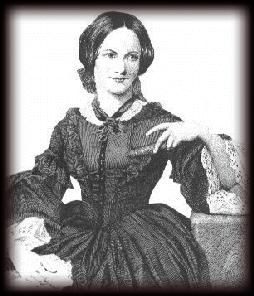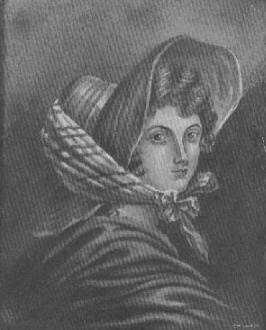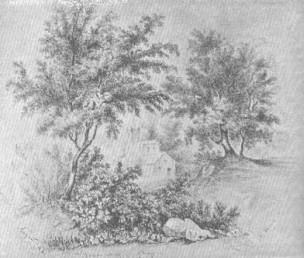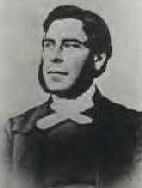Jane Eyre, the musical classic
The Real Jane Eyre

Charlotte Bronte

Emily Bronte, from a painting by Charlotte Bronte. First published in the July 1894 issue of The Woman At Home.
“For
liberty I gasped; for liberty I uttered a prayer.”
Charlotte Bronte, Jane Eyre
You
might say there was a real–life Jane Eyre. For even if Jane’s fictional
life was not precisely an autobiography of her author Charlotte Bronte,
the parallels between Charlotte’s and Jane’s lives are too similar to go
unnoticed.
Born in 1816 to poor Irish
parents who both wrote poetry, novels, and essays, Charlotte Bronte was
the youngest child in a family of five girls and one boy.
The Bronte household was often unpleasant. Charlotte’s mother was the
victim of her husband’s power–lust; she never asked for bread at supper
without apologizing afterward, and Charlotte’s father enjoyed shooting
off a gun inside the house to "teach his wife calmness." Another
account, told even in the somewhat romanticized Victorian biographies,
relates that Charlotte’s mother once received a silk dress and matching
shoes as a gift from her aunt—but Charlotte’s father promptly cut the
dress into little pieces and threw them into the fireplace in order to
“teach his wife humility.” Yet, as one Victorian biographer stated: “A
man cannot always badger a woman; God is good—she dies.” And so
Charlotte’s mother died of cancer after only eight years of marriage.
After his wife’s death, Mr. Bronte’s sister moved into the home. Though
her purpose there was to comfort and care for the children, she was
strict and forbidding, and gained none of their love. In an honest
effort to educate his daughters, Mr. Bronte eventually sent four of his
children to a charity school—a miserable place with a “tyrannical
disciplinary system.” The children were so ill–fed and poorly clothed
that all became ill. Two died of consumption and typhoid fever.
Charlotte and her sister Emily were withdrawn just in time to save their
lives.
When Charlotte grew into a young
woman, she became a teacher and private governess—a job she often found
frustrating. Though she herself referred to her vocation as “wretched
bondage,” she stubbornly remained independent by rejecting several
proposals of marriage. However, Charlotte did fall in love with a
married man—Constantin Heger, the master of a school where she taught.
Eventually, she left that school, but sent pathetic love letters to the
master; many will sound hauntingly familiar to readers of
Jane Eyre.
Heger received them coolly and eventually stopped bothering to answer.
Charlotte’s writing, which she had used as her “escape” since childhood,
now became even more important. (See the end of this article for a copy
of one of Charlotte's letters to Heger.)

A sketch by Charlotte Bronte, sent to Professor Heger, the infamous inspiration for her later novel The Professor. From the July 1894 issue of The Woman At Home.
Money always being scarce in the Bronte family, the three surviving
Bronte sisters decided to write a book of poetry. Mr. Bronte’s immediate
reaction was anger, but he grew more understanding when his daughters’
royalties—though paltry—rolled in. Shortly after, in her tiny,
meticulously neat handwriting, Charlotte wrote
Jane Eyre,
which she published under a man’s name (Currer Bell) in hopes of having
it treated more seriously by literary critics. It was. Charlotte Bronte,
at age 31, was an instant literary lion.
Jane Eyre
was called the breathtaking work of a genius. It was considered
ground-breaking, and critics everywhere were amazed by the young heroine
who lived by her heart—not by society’s rules. Though
Jane Eyre
brought Charlotte fame and gave her the unsurpassed opportunity to
become friends with her literary idols (including James Thackery and
Robert Browning), soon after the book appeared, her brother tragically
died as an alcoholic and drug addict. Within months of his death, her
remaining sisters, including Emily Bronte (author of
Wuthering
Heights)
died of tuberculoses.
Left living alone with
her father, Charlotte married at 38. (Her father failed to appear at the
wedding, favoring instead a local tavern, and a friend had to give the
bride away.) Though Charlotte published three more novels (one
posthumously), in 1855, less than a year after her wedding, she was dead
due to complications during pregnancy.

A photograph of Charlotte Bronte's husband, Reverand A.B. Nicholls.
~~~
Letter
from Charlotte Bronte, to Professor Constantin Heger
"January 8, 1845
Monsieur, the poor have not need of much to sustain them--they ask only
for the crumbs that fall from the rich man's table. But if they are
refused the crumbs they die of hunger. Nor do I, either, need much
affection from those I love. I should not know what to do with a
friendship entire and complete--I am not used to it. But you showed me
of yore a little interest, when I was your pupil in Brussels, and I hold
on to the maintenance of that little interest--I hold on to it as I
would hold on to life."
Isn't There Another Jane Eyre musical? Quiz